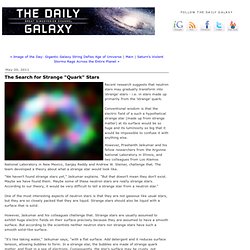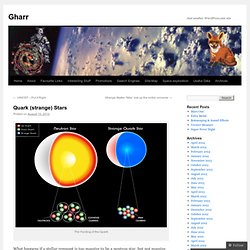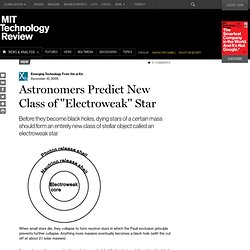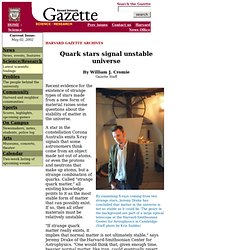

Stars so weird that they make black holes look boring. The Search for Strange "Quark" Stars. Recent research suggests that neutron stars may gradually transform into 'strange' stars - i.e. in stars made up primarily from the 'strange' quark.

Conventional wisdom is that the electric field of a such a hypothetical strange star (made up from strange matter) at its surface would be so huge and its luminosity so big that it would be impossible to confuse it with anything else. However, Prashanth Jaikumar and his fellow researchers from the Argonne National Laboratory in Illinois, and two colleagues from Los Alamos National Laboratory in New Mexico, Sanjay Reddy and Andrew W. Steiner, challenge that. The team developed a theory about what a strange star would look like.
Quark (strange) Stars. The Hunting of the Quark What happens if a stellar remnant is too massive to be a neutron star, but not massive enough to become a black hole?

The result is a Strange Quark Star. Strange because the Quarks all get converted to a type called strange-quarks. Quark stars might actually be larger than their neutron star cousins. This size versus mass may be one of the things that will give away a Quark (strange) Star. Quark star may have enough gravitational energy to start ‘burning’ strange matter. The electroweak star core would be as big as an apple, but as massive as two Earths. Saving the best till last, the electroweak star’s core would therefore be as extreme as the universe was only 10-10 seconds (that’s 0.0000000001 seconds) after the Big Bang. Making Big Bang Soup I know you do not know that I like astronomy considerably and am not afraid to pull up theories of my very own.
Well If these stars existed in the very early universe. Quark Star (update) Some of the strange stuff that is coming out about quark stars: 1) that quark stars may be connected to dark matter (or even dark energy?) Some dark matter might just be “strangelets” roaming the cosmos, blasted free from quark stars: or 2) That some smaller sized black holes may actually be quark stars: “Some black holes may actually be ‘quark stars’:” or 3) The light given off by a quark star is called bremsstrahlung emissions.
“quark star: gives off dim light (called bremsstrahlung emission), emitted by a thin layer of electrons on its surface:” or. We may have witnessed the creation of a quark star. Astronomers Predict New Class of "Electroweak" Star. When small stars die, they collapse to form neutron stars in which the Pauli exclusion principle prevents further collapse.

Anything more massive eventually becomes a black hole (with the cut off at about 2.1 solar masses). In recent years, however, astrophysicists have calculated that a star’s evolution into a black hole is more complex than originally thought. That’s because after the Pauli exclusion effect is breached, star stuff undergoes other nuclear phase transitions that release enough energy to delay collapse, albeit for a relatively short time. For example, astrophysicists recently discovered a state between a neutron star and a black hole in which the star’s mass is supported by the energy released as nuclear matter is compressed into quark matter. So-called quark stars are thought to look very much like neutron stars so finding them will be tricky.
This occurs when the quarks are squeezed so hard that they turn into a type of elementary particle called a lepton. Harvard Gazette: Quark stars signal unstable universe. By William J.

Cromie Gazette Staff Recent evidence for the existence of strange types of stars made from a new form of material raises some questions about the stability of matter in the universe. A star in the constellation Corona Australis emits X-ray signals that some astronomers think come from an object made not out of atoms, or even the protons and neutrons that make up atoms, but a strange combination of quarks. Called "strange quark matter," all existing knowledge points to it as the most stable form of matter that can possibly exist.